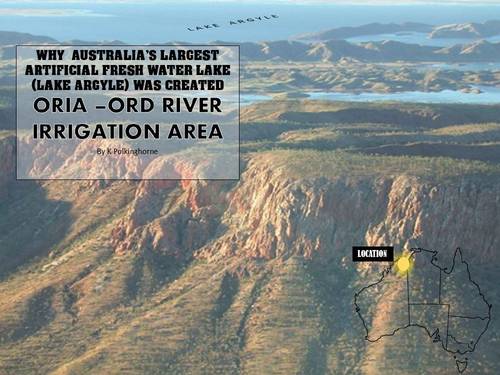


Australians in general have some fascination with water. The majority of the population live within 50 kilometres of the coastline. Inland, water dominates interest by its absence or shortage. In the tropical north lands water dominates by its absence (dry season) or its excess (wet season floods) In the first 3 months of 2019 water dominated by the news of extensive droughts over much of eastern Australia. This was followed by large floods in areas of Queensland south of the Gulf of Carpentaria where intense monsoon rains covered the landscape and drowned several hundred thousand cattle on low-lying areas.
This unit has a focus on the remote area of far north-east Western Australia (The NE Kimberley) where the usual climate provides a wet incoming monsoon season and a very dry outgoing monsoon season. Adjacent to the Ord River lie extensive areas of relatively flat generally productive black soil. This land was marked as suitable for large scale crop production IF sufficient supplies of water could be provided to establish irrigation systems. The potential water was available in the nearby Ord River which flooded during the wet season but dwindled in volume during the dry season. The solution was recognised. Control the
excess river flow during the wet season by initially creating a diversion dam and lake and then release the water onto the dry land during the dry months. Stage 1 (Ivanhoe Plains) was established. There were other vast areas of suitable land waiting for the application of water for irrigation. Solution - create a very large storage reservoir by impounding the river close to its watershed.
This unit is about an inland water storage; a landscape modification; the control of a river system; the development and growth of irrigation crop production over large expanses of plains; the enticement of people to come to the underpopulated tropical regions of Northern Australia; the enthusiasm for commercial crops that would cover the irrigated lands. There were problems that curbed this early enthusiasm but that is covered in the follow up unit on early crop failures in rice growing, sugar growing and cotton growing. It should also be noted that the ORIA (Ord River Irrigation Area) is at this stage (2019) still un the stage of development with further irrigation expansions are projected but still under construction. This gives your students an opportunity to provide updates. The attachment page provides directed questions for discussion/student response/screen use.
One point of clarification. Some references refer to the Lake Gordon/Lake Peddar Storages in Tasmania as the largest inland water storages. However - they are two linked storages. Lake Argyle is one storage.
Something went wrong, please try again later.
This resource hasn't been reviewed yet
To ensure quality for our reviews, only customers who have downloaded this resource can review it
Report this resourceto let us know if it violates our terms and conditions.
Our customer service team will review your report and will be in touch.